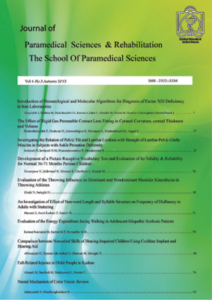Distribution of Pupil Diameter and Their Related Factors in 40-64 Years Old Population of Shahroud
Authors
H Hashemi 1 , M Khabazkhoob 2 , M.H Emamian 3 , M Shariati 4 , A Fotouhi 5
Affiliations
1 Professor of Ophthalmology, Noor Ophthalmology Research Center, Noor Eye Hospital, Tehran, Iran
2 PhD of Epidemilogy, Noor Ophthalmology Research Center, Noor Eye Hospital, Tehran, Iran
3 Assistant Professor of Epidemiology, Center for Health Related Social and Behavioral Sciences Research, Shahroud University of Medical Sciences, Shahroud, Iran
4 Associated of Professor of social medicine, Department of Community Medicine, School of Medicine, Tehran University of Medical Sciences, Tehran, Iran
5 Professor of Epidemiology, Department of Epidemiology and Biostatistics, School of Public Health, Tehran University of Medical Sciences, Tehran, Iran
Abstract
Purpose:
To determine the mean pupil diameter by the Pentacam in the 40-64 year-old population of Shahroud and its association with some related factors.
Methods:
Three hundred clusters were selected through multistage cluster sampling in the first phase of Shahroud Cohort study of whom 82.2% participated in the study. Refraction, slit lamp examination, and imaging by the Pentacam were performed for all participants. The pupil diameter obtained by the Pentacam was analyzed. Any history of previous ocular surgery and invalid Pentacam data were the criteria for excluding data from further analysis.
Results:
After implementing the exclusion criteria, the data of 3820 individuals (59.3% female) were analyzed. The mean pupil diameter in this study was 2.74±0.56 mm (95%CI 2.72-2.76). The 25%, 50%, 95% and 97.5% percentiles of the pupil diameter in the study population were 2.41, 2.67, 3.60 and 3.85mm, respectively. In this study, the 95% of the normal range of pupil diameter was 1.63-3.85mm. In the multiple model, the mean pupil diameter was smaller in men compared to women and decreased significantly with aging (P<0.001). The mean pupil diameter was significantly larger in myopic versus hyperopic participants (P<0.001). The pupil diameter was significantly smaller in participants with dark brown irises (P=0.005). Anisocoria was observed in 9.43% (95%CI 8.43-10.44) of the participants.
Conclusion:
The pupil diameter in normal individuals by the Pentacam is found to be smaller than other techniques. A cut point of 3.85mm for the pupil diameter is suggested as the critical criterion for refractive surgery. Moreover, it should be noted that men have a smaller pupil diameter, and that the pupil diameter decreases with aging.
Keywords: Pupil Diameter , Population Based Study, Pentacam

